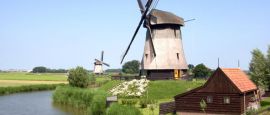Getting around Netherlands
There is an excellent road system, although it can become very busy at times around major centres. There is a chronic shortage of parking space in central Amsterdam, and the rush hours (0700-0900 and 1700-1900) should be avoided throughout the whole country. There are only two toll roads in The Netherlands: the Western Scheldt Tunnel and the Dordtse Kil.
Roads are well signposted with green 'E' symbols indicating international highways, red 'A's indicating national highways, and smaller routes indicated by yellow 'N's.
Available from airports, main hotels and many other locations in the major cities. All major international car hire companies are represented. Drivers must be at least 18 years old.
Taxis are metered and have an illuminated sign on the roof. Rather than hailing taxis in the street, you should either book by phone or go to a taxi stop.
With some 29,000km (over 18,019 miles) of signposted bicycle lanes and primarily flat terrain, the Netherlands is a cyclist's dream. Two-wheel travel within and between urban areas is an economical and enjoyable alternative to driving.
You can hire bikes at or near all main railway stations. If you've got your own bike, you may put it on a train (in cars marked with the bicycle icon) for a fee; folding bikes travel free.
Buses provide regional transport within The Netherlands, while intercity travel is covered by the train network. Among the main operators are Conexxion (tel: 0900 266 6399, within the Netherlands only; www.connexxion.nl) and Arriva (tel 0800 023 2545, within the Netherlands only; www.arriva.nl). For enquiries about routes, use 9292.nl.
Drivers should be particularly aware of cyclists; often there are special cycle lanes. Speed limits are 100-130kph (62-81mph) on motorways, 80kph (50mph) on major roads and 50 or 30kph (31mph) in towns.
The yellow cars of the ANWB/Wegenwacht (Royal Dutch Touring Club) (tel: +31 88 269 2222, within the Netherlands only; www.anwb.nl) patrol major roads 24 hours a day with qualified mechanics equipped to handle routine repairs. In case of emergencies, assistance is available.
An International Driving Permit is recommended for non-EU visitors, though is not compulsory, as long as you hold a driving licence from your country of origin. EU pink format licences are accepted. A Green Card is advisable, but not compulsory. Without it, drivers with motor insurance policies in their home country are granted only the minimum legal cover in the Netherlands; the Green Card tops this up to the level of cover provided by the driver's own policy.
Getting around town is a cinch with safe, efficient and easy-to-use public transport systems the norm in cities throughout the Netherlands. Extensive networks of buses, trams and ferries operate in the largest cities, Amsterdam, Rotterdam and Den Haag; the first two feature metro lines as well. Buses generally stop running around midnight but night networks operate in the main urban areas.
The easiest way to pay is using an OV-Chipkaart smartcard, which can be used on public transport throughout the country. For short-term visitors, the best option is to purchase 'disposable' single card or an anonymous OV-chipkaart, allowing unlimited travel on public transport during a specified period. You can buy these at public transport outlets, in tobacco shops, in several supermarkets or at vending machines in the stations. Otherwise, it is possible to purchase a one-hour card when you get on the bus or tram.
Another good option for getting around town is to rent a bike; rentals are available from bike shops throughout the Netherlands.
The highly developed rail network is efficient and cheap, and connects all towns. Both intercity and local trains run at least half-hourly on all principal routes. Rail and bus timetables are integrated, and there is a common fare structure throughout the country.
NS (tel: +31 30 751 5155; www.ns.nl) is the national rail company and operates most services within the country. Regional rail-bus companies cover routes in the more remote areas of the north and east of the country. You can buy tickets at ticket offices or machines in the stations; e-tickets are also available via the NS website.
Dal Voordeel: grants travellers a 40% discount on rail travel throughout the Netherlands during off-peak hours and weekends. The discount also applies for up to three travelling companions. Available online from the NS website.
InterRail Benelux Pass: offers travel for three, four, six or eight days in one month within Belgium, Luxembourg and the Netherlands. Travel is not allowed in the passenger's country of residence. Travellers under 27 years receive a reduction. Children under 12 travel free when accompanied by an adult using an Adult Pass. Supplements are required for some high-speed services, seat reservations and couchettes. Discounts are offered on Eurostar and some ferry routes. Available from the InterRail website (https://www.interrail.eu).
There are regular ferry services to the Wadden Islands (Ameland, Schiermonnikoog, Terschilling, Texel and Vlieland) across the Ijsselmeer (former Zuyder Sea) and Schelde Estuary. There is also a service to the Frisian Islands across the Waddenzee. The main ferry operator is Teso (tel: +31 222 369 600, within the Netherlands only; www.teso.nl).
Numerous operators offer river and canal cruises from main centres around the Netherlands. Note: No cars are permitted on Vlieland. Cruise ships regularly call at Passenger Terminal Amsterdam (www.ptamsterdam.nl), close to the city centre.
Do you have any Feedback about this page?
© 2025 Columbus Travel Media Ltd. All rights reserved. No part of this site may be reproduced without our written permission, click here for information on Columbus Content Solutions.




 You know where
You know where